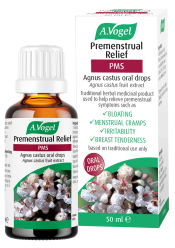Menstrual migraines
Around 50% of women who suffer from headaches or migraines say that their menstrual cycle is the root cause.
In order to see if your headache misery falls into this category it makes perfect sense to keep a ‘Headache Diary’ for at least 3 months, as this may pinpoint if indeed there is a monthly pattern.
Log points such as:
- When do the headaches start/stop?
- Are they worse if you are tired/stressed?
- Are they worse after eating or drinking certain things?
If they do occur at the same time every month then congratulations, you appear to have menstrual migraines! Symptoms of which may also included nausea and sickness.
The main cycle stages for PMS headaches appear in the week before your period including the week of your period, and the trigger for these stages is the dropping oestrogen levels which occur at this point.
Are there any treatments?
Yes, there are both supplemental and lifestyle routes for prevention as well as treatment.
The supplement route can include:
1. Feverfew
The vascular dilating properties of this herb help relax the blood vessels allowing the blood to flow through them more easily. This reduces the pressure that causes headaches and should be taken all month long.
2. Magnesium
A lot of women are magnesium deficient and these levels drop even more just before your period. Magnesium helps to relax the nervous system; this includes the blood vessels, which constrict during a migraine attack. Foods enriched with magnesium include fish, bananas and dark leafy greens.
3. Vitamin B complex
This vitamin group can gently restore energy to the nerve cells, helping to prevent headaches and control blood flow. It is always better to take a B complex i.e. all the B vitamins, than an individual one. To obtain your B vitamins through food, look at wholegrain foods, to get most from the group and add eggs, fish or meat to make up the balance.
4. Anti Inflammatory painkillers – such as ibuprofen
You can pre-empt your migraines and take these 3-5 days before symptoms usually occur (we would advise that you speak to your G.P. if this in an option you would like to try).
The lifestyle route can include:
1. Exercise
Exercise is a great stress reliever. Boosting endorphins and relaxing muscles can both help alleviate headaches. Although aerobic exercise may produce better results, a brisk 20 minute walk each day may be enough to help.
2. Food
Low blood sugar levels can be a cause of headaches. If you feel shaky, faint or irritable, should you miss a meal, then this could be you. Cut back on caffeine, alcohol, salt and sugary snacks – if you cannot do this all month then at least try to do so during the run up to your period. Chromium is an excellent blood sugar controller, and broccoli is a good example of an enriched chromium food.
Another point to bear in mind is that food intolerances can cause headaches, even if you are not affected in the other three weeks of the month, your body sometimes cannot cope with your period and these intolerances.
3. Drink water
Water flushes out the system getting rid of impurities and also helps to stop swelling and bloating, both of which can trigger headaches. Therefore, make sure that you are drinking at least 8 glasses of plain water every day.
4. Sleep
Try to get a good night’s sleep as this helps to keep your stress levels down, which aids in keeping PMS migraines at bay. Need help getting a better night’s sleep? Visit our Sleep Health Hub for lots of tips and advice, as well as helpful suggestions and natural sleep solutions.
The triggers for menstrual migraines can, and do, differ greatly from woman to woman, which is why a ‘Headache Diary’ is a great concept to try for 3 months, as this could identify your own trigger, and once identified, a solution may hopefully be found by taking a supplement or making a lifestyle change.
How do you help ease headaches or migraines? Share your tips and advice in the comment section below.








